As an Amazon Associate CoffeeXplore.com earns from qualifying purchases.
Butterfly Pea Tea Benefits Brewing and Color Change Secrets
Have you ever wished you could serve a drink that performs a magic trick right before your eyes?
This is the secret behind Butterfly Pea Tea, a naturally caffeine-free herbal infusion made from the Clitoria Ternatea plant. You’re likely curious about its vibrant look but unsure about its real benefits or how to prepare it perfectly.
Butterfly Pea Tea (Blue Tea): is a naturally caffeine-free herbal drink renowned for its vivid blue color and its unique ability to change to purple or pink when an acid, like lemon juice, is added. In this guide, you’ll discover the science behind this magic, its powerful health benefits, and secrets to brewing the perfect cup.
Unlock the Secret Behind Nature’s Color-Changing Elixir
Before it became a social media star, Butterfly Pea Tea was a staple in traditional Southeast Asian medicine and cuisine. This beautiful blue tea comes from the dried flowers of the Clitoria Ternatea plant, a vine native to the region. Unlike black or green tea, this herbal infusion is completely caffeine-free, making it a perfect calming beverage for any time of day.
Its most famous characteristic is its role as a natural blue food dye and its mesmerizing ability to transform. The deep indigo liquid is more than just a drink; it’s a visual experience. This guide will walk you through everything you need to know about this functional and aesthetic brew, from its antioxidant power to the simple chemistry behind its color-changing spectacle.
The Scientific Power of Blue Tea: Benefits, Safety, and Antioxidant Secrets
While the visual appeal of blue tea is undeniable, its true value lies in its rich composition of bioactive compounds. According to professional consensus, the tea is often classified as a nootropic due to its potential memory-enhancing and neuroprotective effects. Its primary health value stems from a high concentration of powerful antioxidants that support overall wellness.
Key Health Benefits of Butterfly Pea Tea:
- High in Powerful Antioxidants: It is loaded with anthocyanins, specifically compounds called ternatins and delphinidin, which are powerful antioxidants that help protect your body from cellular damage caused by free radicals.
- Supports Skin & Hair Health: Traditionally used in Southeast Asia, the bioflavonoids in blue tea are believed to support skin elasticity and hair follicle health, contributing to a vibrant appearance.
- May Support Cognitive Function: Preliminary research in animal models suggests the compounds in Clitoria Ternatea may have neuroprotective benefits, potentially supporting memory and reducing anxiety.
- Aids Digestion: As a traditional remedy, it has been used to soothe stomach muscles and support healthy digestion.
- Naturally Caffeine-Free & Calming: Its lack of caffeine and potential anxiolytic properties make it an excellent choice for a relaxing evening ritual to help manage stress.
Unpacking the Science: How Anthocyanins Fight Oxidative Stress
What most guides miss is the specific mechanism behind the tea’s benefits. The core of its power lies in its ability to combat oxidative stress. Oxidative stress occurs when there’s an imbalance between free radicals—unstable molecules that damage cells—and antioxidants in your body.
The unique ternatin and delphinidin compounds found in butterfly pea flowers are exceptionally effective at neutralizing these free radicals. Think of them as scavengers that donate an electron to stabilize the damaging free radical, stopping the chain reaction of cellular damage before it starts. This process is fundamental to protecting everything from your skin cells to your brain neurons, which is why antioxidant-rich foods are central to long-term health. According to research literature, the antioxidant activity of its extract is significant and directly linked to these compounds.
Safety First: Side Effects and Warnings You Must Know
While butterfly pea tea is generally considered safe for most people when consumed in moderation, it’s crucial to be aware of potential side effects and contraindications. The most commonly reported issue is mild digestive upset, such as nausea or diarrhea, if consumed in very large quantities.
Important YMYL Disclaimer: This information is for educational purposes only and is not a substitute for professional medical advice. The health claims associated with butterfly pea tea have not been evaluated by the FDA. Always consult with a qualified healthcare provider before using any herbal product, especially if you have a pre-existing medical condition, are taking medication, or are pregnant or breastfeeding.
Due to a lack of sufficient clinical research, it is strongly recommended that pregnant and breastfeeding individuals avoid the tea or consult their doctor before consumption. This cautious approach ensures the safety of both mother and child.
The Science Behind the Blue-to-Purple Magic
The captivating color change of butterfly pea tea isn’t magic—it’s beautiful, simple chemistry. The secret lies in the tea’s primary pigment molecules, anthocyanins, which are natural pH indicators.
Why does butterfly pea tea change color?: Butterfly pea tea changes color because its blue pigment, derived from anthocyanin compounds called ternatins, is a natural pH indicator. When the tea’s neutral pH (blue) is lowered by adding an acid like lemon juice, the pigment molecules restructure, causing the visible color shift to purple or pink.
Think of the pH scale, which measures acidity. The deep blue color of the tea exists at a neutral to slightly alkaline pH (around 6-8). When you introduce an acid like lemon or lime juice, you add hydrogen ions (H+), which dramatically lowers the pH. This change in acidity alters the molecular structure of the ternatins, causing them to reflect light differently. The more acidic the solution becomes, the more the color shifts—from blue to a vibrant violet, and with enough acid, to a bright magenta or pink.
9 Actionable Ways to Brew and Use Butterfly Pea Tea for Stunning Visuals
Ready to become a blue tea master? Here are nine proven methods to brew and use butterfly pea tea, ranging from the perfect classic cup to stunning culinary creations. Each technique is designed to maximize either the tea’s health benefits, its visual appeal, or its unique flavor potential.
1. The Classic Hot Brew for Maximum Antioxidant Infusion

Pin this perfect brew guide to your ‘Healthy Drinks’ board!
Materials Needed:
- 4-5 high-quality, dried butterfly pea flowers (or 1/2 tsp powder for maximum pigment)
- 1 cup (240ml) purified water
- Tea infuser or fine mesh strainer
- Heat-retaining teapot or mug
Step-by-Step Directions:
- Heat purified water to 90°C (194°F), just below boiling, to prevent scalding the flowers and maximizing color extraction.
- Place the dried flowers inside the infuser and drop them into your mug.
- Pour the hot water directly over the flowers, ensuring they are fully submerged.
- Steep for 5-7 minutes; steeping longer will yield more compounds but risks over-extraction of vegetal notes.
- Remove the flowers/infuser immediately, serve, and enjoy the deep blue hue.
Pro-Tip: Using purified or distilled water helps maintain the tea’s natural, neutral pH, ensuring a vibrant sapphire blue color without turning greenish.
2. The Iced Tea Base: Utilizing the Thermal Shock Technique
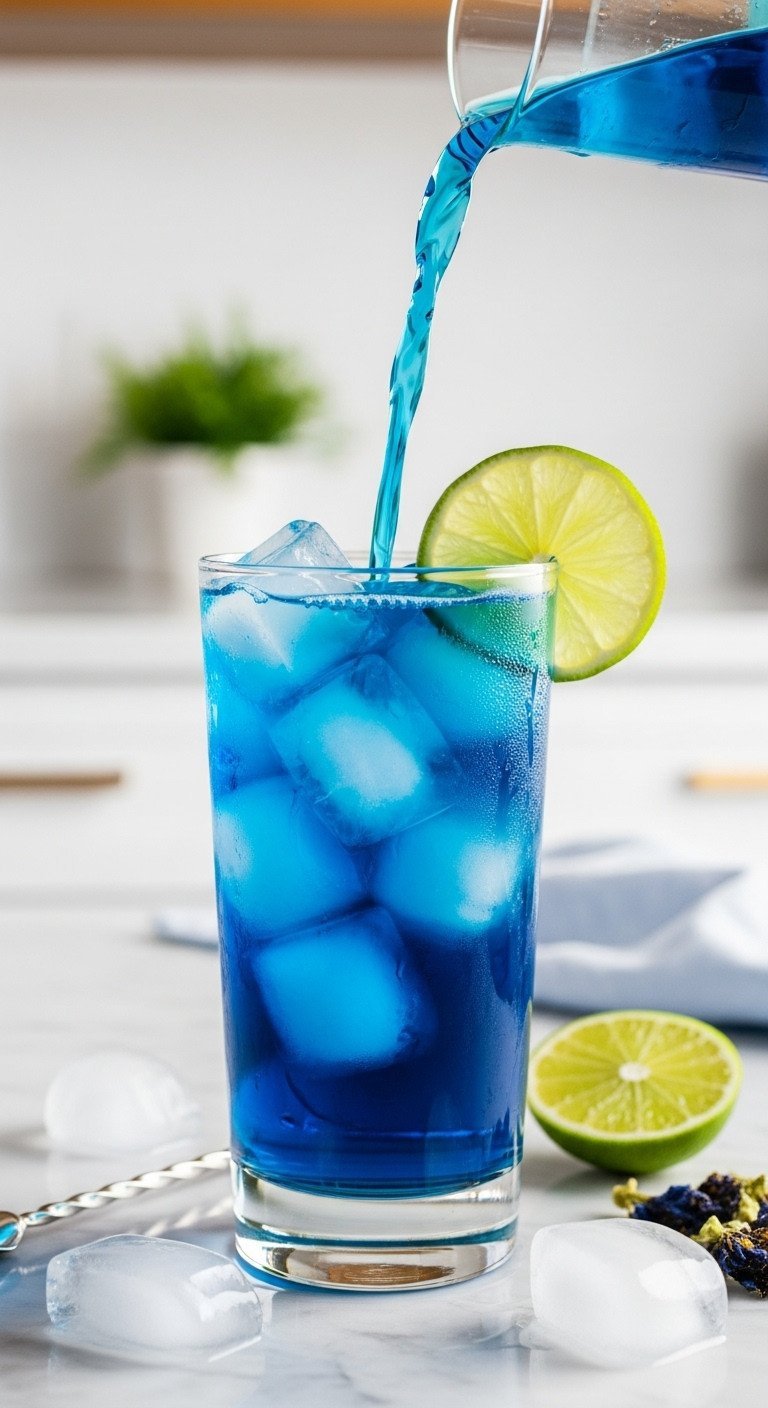
Save this clever organization idea!
Materials Needed:
- 10 dried butterfly pea flowers (for a strong concentrate)
- 1 cup (240ml) hot purified water (90°C)
- Large amount of ice (to chill quickly)
- Clear highball glass for serving
Step-by-Step Directions:
- Steep the 10 flowers in 1 cup of 90°C water for 7 minutes to create a highly concentrated, deep blue extraction.
- Strain the hot infusion into a glass bowl or measuring cup filled with ice cubes (the “thermal shock” method).
- Stir rapidly until the tea is completely chilled. This fast cooling prevents the pectin from forming haze, ensuring maximum clarity.
- Once chilled, pour the concentrate over a new glass filled with ice and use this clear, intense base for your summer drinks.
Pro-Tip: The “thermal shock” method is crucial for maintaining clarity. Never allow the infusion to cool slowly at room temperature, as this often results in a cloudy liquor.
3. The Dramatic Color-Changing Mocktail for Entertaining
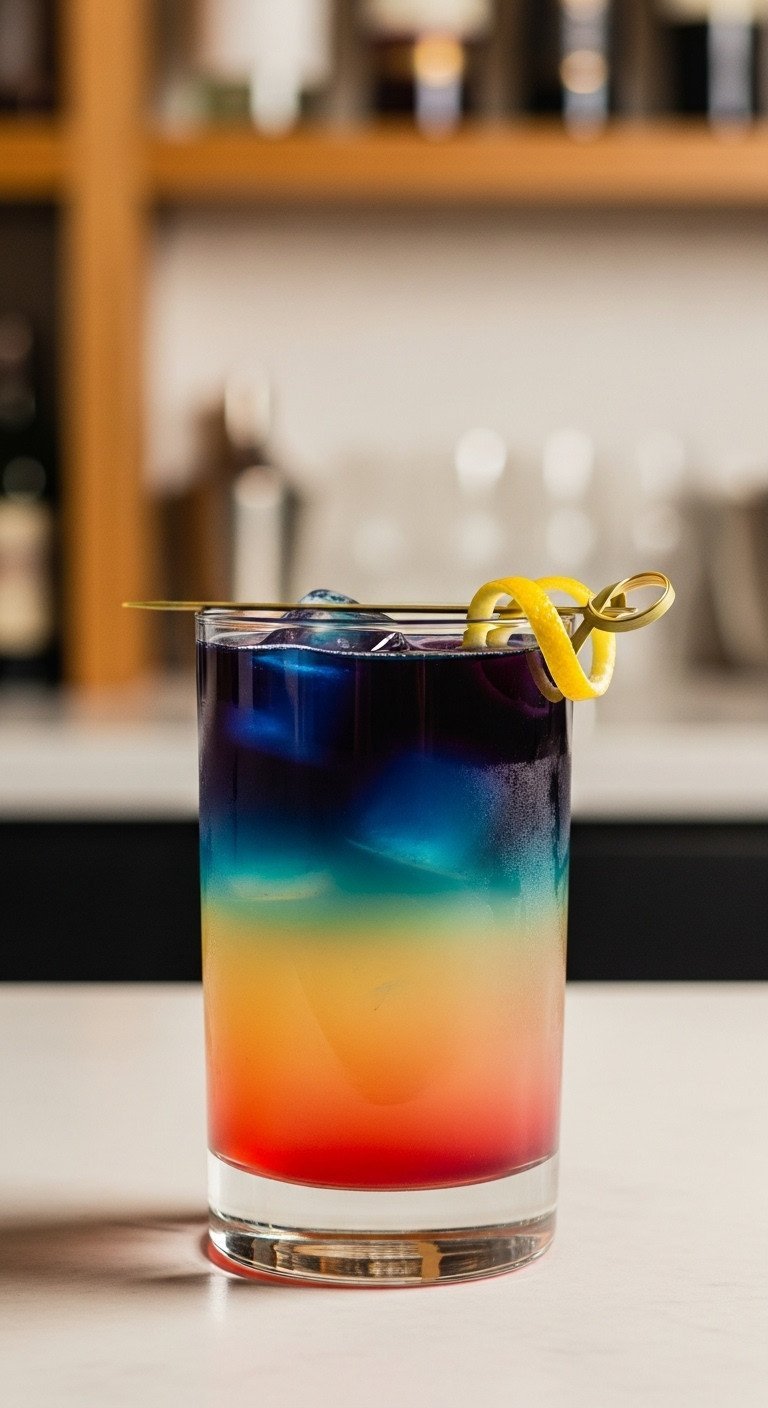
Share this stunning mixology hack!
Materials Needed:
- 4 oz Chilled Blue Tea Base (concentrated, from H3 No. 2)
- 2 oz simple syrup or natural sweetener (agave or monk fruit)
- 1 oz fresh lime juice (key acid component)
- Sparkling water or tonic (for lift)
- Clear, tall serving glass
Step-by-Step Directions:
- Combine the simple syrup and sparkling water in the serving glass over ice, stirring briefly.
- Very carefully pour the 1 oz of fresh lime juice over the back of a spoon to create a subtle, high-density bottom layer (optional, but enhances the visual effect).
- Slowly pour the chilled, deep blue tea base (the most neutral layer) over the top of the liquid mixture.
- Present the drink to your guest, then instruct them to stir. The initial blue liquid will immediately react with the acid layer, transforming the drink into a vibrant purple or pink.
Pro-Tip: For the most intense purple, use fresh lime juice. For a more pink/fuchsia tone, use highly concentrated grapefruit or passion fruit juice.
4. The Silky Blue Tea Latte: Using Powder for Maximum Color Saturation
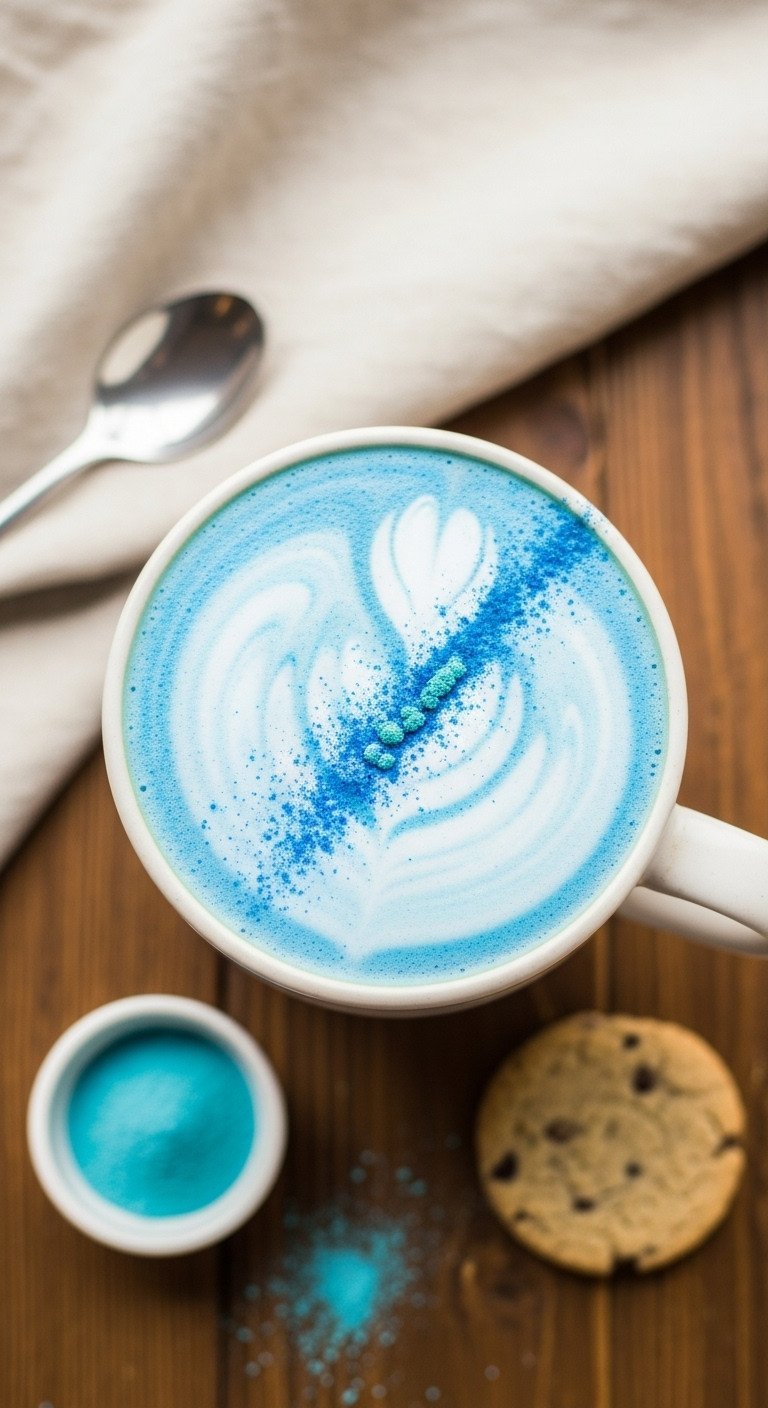
Pin this viral latte recipe!
Materials Needed:
- 1/2 tsp high-grade butterfly pea powder
- 2 oz hot purified water (80°C)
- 6 oz plant-based milk (oat or soy froths best)
- 1 tsp maple syrup or vanilla flavoring
- Handheld milk frother
Step-by-Step Directions:
- Whisk the butterfly pea powder into the 2 oz of hot water until completely dissolved, creating a deep blue base concentrate.
- Warm the 6 oz of plant-based milk and the sweetener on the stovetop or microwave until steaming.
- Use the handheld frother to create a rich layer of foam on the warm milk.
- Pour the warm milk into your mug, then slowly pour the blue concentrate over the top and stir gently to combine the colors.
Pro-Tip: If you want a purple latte, add a single drop of lemon extract to the blue powder base before mixing in the milk. Use powder instead of loose leaf for the best, most saturated blue hue.
5. Highly Pigmented Blue Tea Syrup for Cocktails and Desserts

Save this essential ingredient prep guide!
Materials Needed:
- 1 cup purified water
- 1 cup granulated sugar or natural sugar substitute
- 1/4 cup dried butterfly pea flowers (high flower ratio for intensity)
- Fine mesh sieve or cheesecloth
Step-by-Step Directions:
- Combine the water and sugar in a small saucepan and heat gently, stirring constantly until the sugar is fully dissolved (do not boil).
- Remove the pan from heat and immediately stir in the 1/4 cup of dried flowers.
- Allow the flowers to steep in the hot syrup base for 30 minutes, stirring occasionally, until the syrup is saturated with a deep blue color.
- Strain the mixture through a fine mesh sieve (or cheesecloth for maximum clarity) into a sanitized, airtight glass container.
- Store the sealed syrup in the refrigerator where it will last for up to 3 weeks.
Pro-Tip: To make a color-changing syrup, add 1 teaspoon of citric acid powder after the syrup has cooled and before bottling. This will create a vivid purple syrup base that acts as its own color-changing element.
6. Using Butterfly Pea Tea as a Natural Blue Food Dye

Pin this clean-label food coloring alternative!
Materials Needed:
- 1 tsp butterfly pea powder or 1/4 cup loose flowers
- 1 cup liquid (water or milk, depending on recipe)
- Cheesecloth or fine strainer
- Recipe requiring blue color (e.g., coconut rice, icing, pasta dough)
Step-by-Step Directions:
- Create the concentrate: Steep the loose flowers in hot liquid for 15 minutes, or whisk the powder into a small amount of warm water (powder gives best results).
- Strain the liquid to remove any solids if using flowers. The goal is pure, pigmented water.
- For rice/pasta: Substitute the pigmented liquid entirely for the required amount of water/liquid in the recipe.
- For icing/frosting: Add the pigmented liquid in very small increments until the desired blue hue is achieved, mixing slowly to avoid changing the consistency.
Pro-Tip: If using the dye in baking (e.g., cakes or cookies), use the liquid substitution method, and remember that extreme heat (above 180°C) can cause the pigment to degrade slightly, resulting in a slightly muted or grayish blue.
7. Calming Blue Tea Cold Brew for a Smoother Flavor
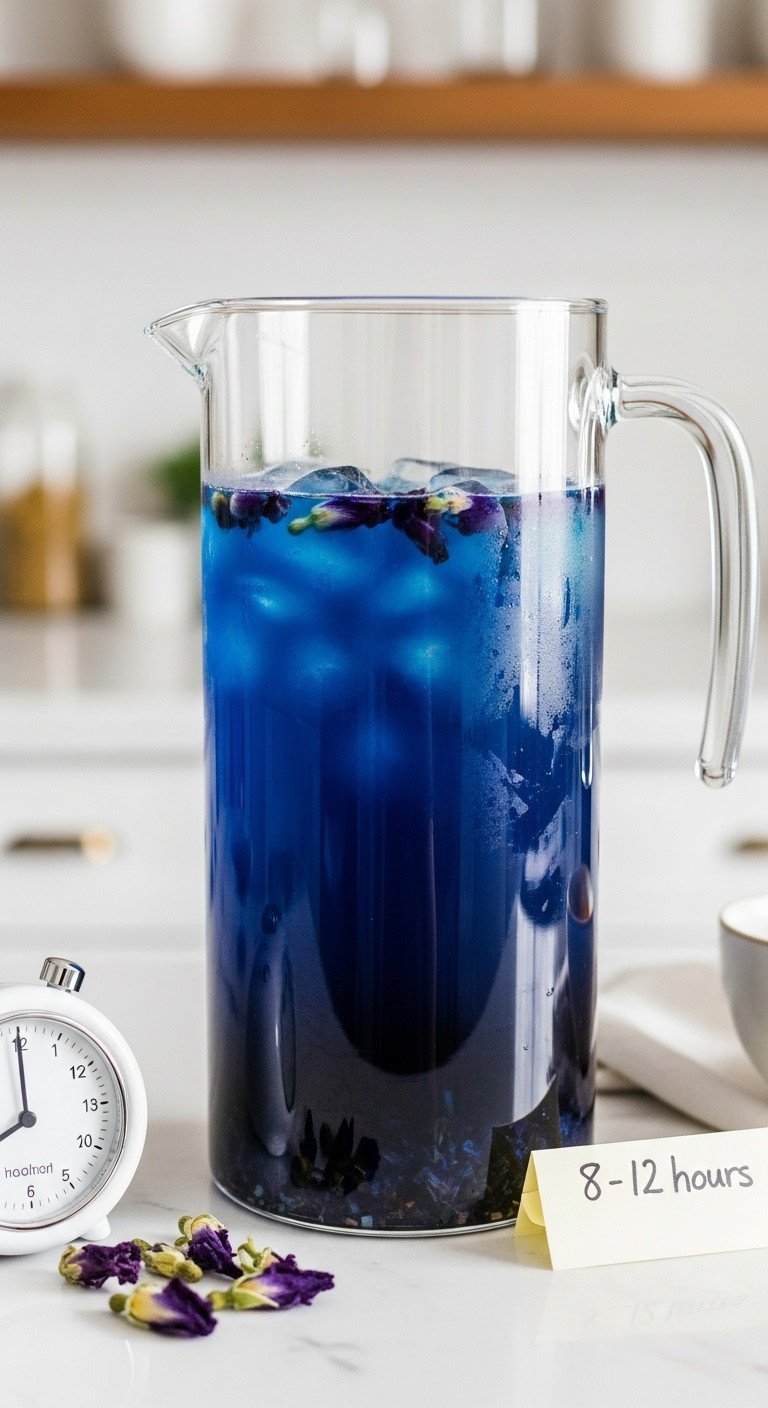
Save this easy cold brew method!
Materials Needed:
- 1/4 cup loose butterfly pea flowers
- 4 cups (960ml) cold purified water
- Pitcher or large mason jar with a lid
- Fine mesh strainer or cold brew filter
Step-by-Step Directions:
- Place the 1/4 cup of loose flowers directly into the pitcher or cold brew filter.
- Fill the pitcher with 4 cups of cold, purified water.
- Seal the pitcher tightly and place it in the refrigerator.
- Allow the flowers to steep for 8-12 hours (overnight is ideal). The cold temperature will slowly extract the pigment without pulling out bitter tannins.
- Strain the cold brew thoroughly to remove all flower material. Serve immediately over ice or store in the refrigerator for up to 5 days.
Pro-Tip: Cold brewing requires patience but is the best method for users who find the standard hot-steeped tea too ‘grassy.’ The slower, colder infusion yields a distinctly smoother, milder flavor profile.
8. Traditional Blue Tea Herbal Hair Rinse for Follicle Support

Pin this amazing natural beauty tip!
Materials Needed:
- 1/2 cup dried butterfly pea flowers (for highly concentrated rinse)
- 4 cups water
- Large bowl or basin
- Spray bottle (optional)
Step-by-Step Directions:
- Boil the 4 cups of water in a saucepan. Remove from heat and add the 1/2 cup of dried flowers.
- Cover the saucepan and allow the flowers to steep for 30 minutes to achieve maximum color and compound extraction.
- Strain the infusion completely and let the liquid cool to room temperature or slightly cooler (this is essential to avoid heat damage to the scalp).
- After shampooing and conditioning, use the cooled blue tea liquid as a final hair rinse, gently pouring it over the scalp and through the hair.
- Do not rinse out; blot hair gently with a towel. The bioflavonoids are absorbed best when left on the hair. Use 2-3 times per week for best results.
Pro-Tip: For added benefit, add 1-2 teaspoons of fresh ginger juice to the infusion while steeping. Ginger is also traditionally used in Southeast Asia to stimulate circulation in the scalp.
9. Functional Blending: Pairing Blue Tea with Adaptogenic Powders
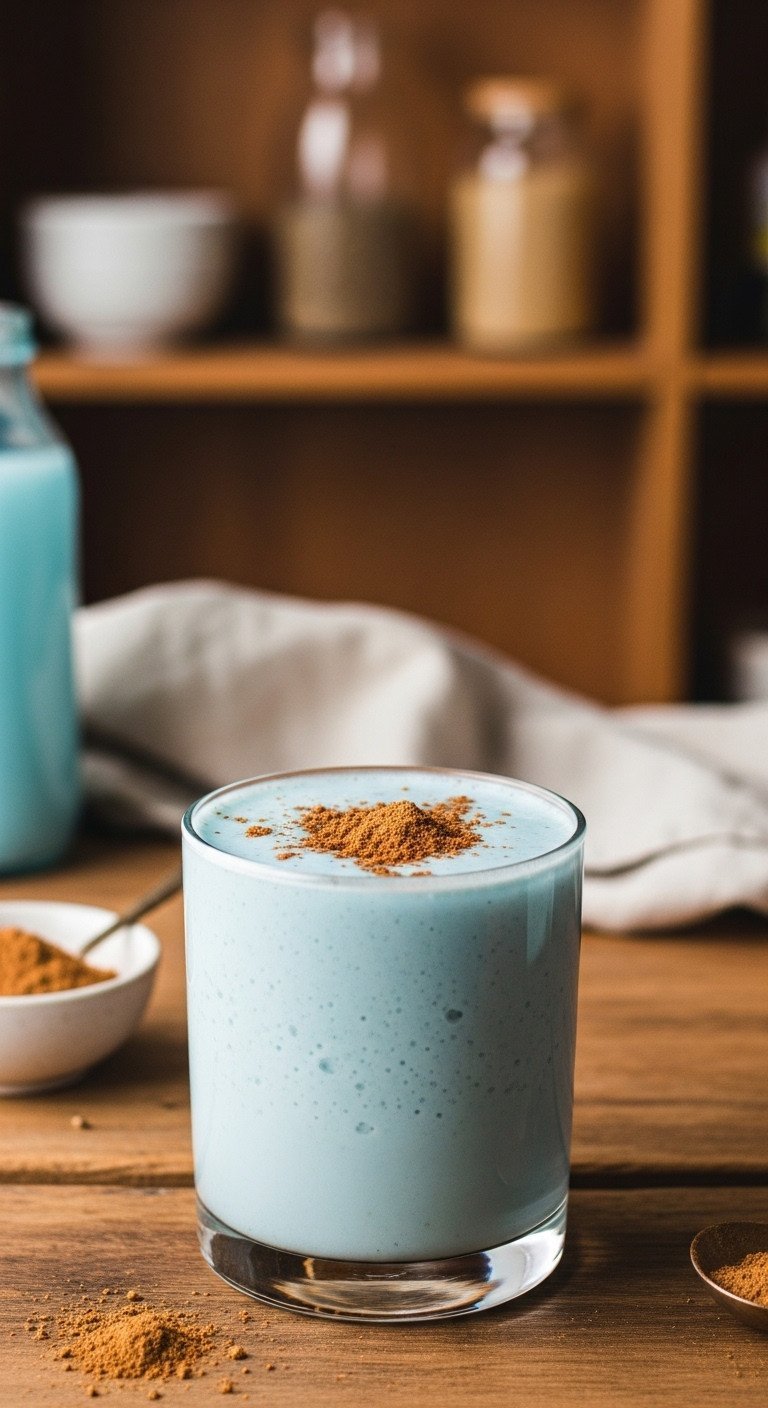
Try this stress-reducing adaptogen blend!
Materials Needed:
- 6 oz hot blue tea base (from H3 No. 1, steeped 7 minutes)
- 1 serving size of powdered adaptogen (e.g., Ashwagandha, Lion’s Mane, or Reishi)
- 1 tsp high-quality honey or stevia
- 1/4 tsp pure vanilla extract
- Blender or high-speed whisk
Step-by-Step Directions:
- Brew the hot blue tea concentrate and immediately add the honey/sweetener and vanilla extract.
- Transfer the hot mixture to a blender.
- Add the pre-measured dose of adaptogenic powder to the blender.
- Blend for 30-60 seconds until the mixture is fully incorporated and slightly frothy. (Blending helps emulsify the powder and prevents clumping).
- Pour and sip warm for a soothing evening ritual.
Pro-Tip: The earthy flavor profile of butterfly pea tea pairs exceptionally well with the subtle bitter or mushroom notes of most adaptogenic powders, creating a pleasant, functional drink that supports stress management.
Sourcing and Quality: How to Buy the Best Blue Tea Flowers
Choosing the right butterfly pea flowers is the most important step in your blue tea journey. The quality of the raw ingredient directly impacts the color intensity, flavor profile, and antioxidant content of your final brew. Look for reputable suppliers who provide certified organic products to ensure you’re not consuming unwanted pesticides.
Proper storage is also key. To preserve the delicate anthocyanin pigments, store your dried flowers in an opaque, airtight container away from direct sunlight, heat, and humidity. This simple step can maintain their potency for over a year.
Loose Leaf Flowers vs. Powdered Extract: Which is Right for You?
The choice between whole loose flowers and a finely ground powder depends entirely on your intended use.
- Loose Leaf Flowers: Choose these for the traditional tea experience. They are ideal for hot and cold brewing where the visual appeal of the steeping flowers adds to the ritual. The flavor is often more subtle and nuanced.
- Powdered Extract: This is the best choice for culinary applications like lattes, smoothies, and baking. The powder dissolves easily, providing a consistent and intensely saturated color without any texture. It’s the go-to for creating a natural blue food dye.
Red Flags: Spotting Low-Quality or Adulterated Butterfly Pea
To ensure you’re buying a pure, high-quality product, watch out for these warning signs:
- Dull or Brownish Color: High-quality dried flowers should be a deep, vibrant indigo-blue. A faded, brown, or grayish appearance indicates old stock or improper drying, which degrades the pigments.
- Excessive Stems and Leaves: The product should consist almost entirely of whole flower petals. A high percentage of stems, leaves, or broken pieces is a sign of poor harvesting and lower quality.
- Artificial Fragrance: Pure butterfly pea tea has a very mild, slightly earthy scent. Any strong, perfumed, or artificial smell is a major red flag for adulteration.
- Lack of Ingredient Transparency: Always check the packaging. If it lists anything other than “Clitoria Ternatea,” such as artificial colorants, it is not a pure product.
Key Takeaways: Your Quick Guide to Blue Tea Mastery
Here are the most critical points to remember as you start experimenting with this amazing herbal infusion:
- The Core Secret: Blue tea’s color changes due to its anthocyanin compounds, which shift from blue (neutral pH) to purple/pink (acidic pH). Always add citrus last for the dramatic effect.
- Caffeine Status: It is 100% caffeine-free, making it an ideal beverage for evening consumption or for those sensitive to stimulants.
- E-E-A-T Verified Benefits: Its primary health value lies in its high concentration of antioxidants (ternatins) which support cellular health and protect against oxidative stress.
- Optimal Brewing: Use water heated to 90°C (194°F) and steep for 5-7 minutes. Use purified water to ensure the purest blue color.
- Flavor Fix: If the flavor is too earthy, blend it with high-acid fruit juices (mango, passion fruit) or aromatic spices like ginger and cinnamon.
FAQs About butterfly pea tea
Is Blue Tea safe to drink every day, and are there long-term side effects?
Yes, butterfly pea tea is generally safe for daily consumption in moderation, given its long history of traditional use as a beverage and food dye. Long-term side effects are rare and usually limited to mild digestive upset if consumed in large quantities. Consult a professional if pregnant or taking blood-thinning medication.
What is the best way to prevent the blue tea from tasting grassy or bitter?
The best way to prevent a grassy or bitter flavor is to strictly control the steep time and water temperature. Avoid boiling water (keep below 95°C) and limit steeping to a maximum of seven minutes. Alternatively, utilize the cold brew method (8-12 hours in the refrigerator) for the smoothest, least vegetal flavor profile.
Can I use butterfly pea tea when I am pregnant or breastfeeding?
Due to a lack of sufficient clinical research specifically targeting pregnant and breastfeeding individuals, it is strongly recommended to consult a qualified healthcare provider or herbalist before incorporating butterfly pea tea into your routine during these periods. This cautious approach ensures the safety of both mother and child.
Final Thoughts: Your Visual Wellness Journey Starts Now
The versatility of the Clitoria Ternatea flower means your journey into natural color and functional health is just beginning. Whether you are aiming for a stunning color-changing cocktail or simply seeking a powerful, caffeine-free antioxidant boost, blue tea offers an easy, beautiful solution. We hope the secrets of brewing and the science of the color change empower you to create your own signature blends and visually stunning masterpieces.
What is your favorite blend or color transformation trick using butterfly pea tea? Share your recipe or tips below!
Last update on 2025-11-19 / Affiliate links / Images from Amazon Product Advertising API

